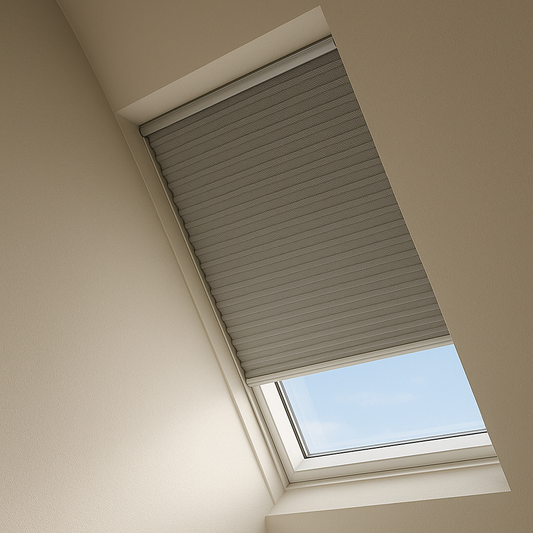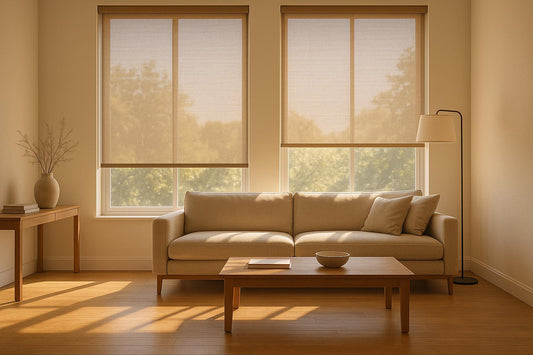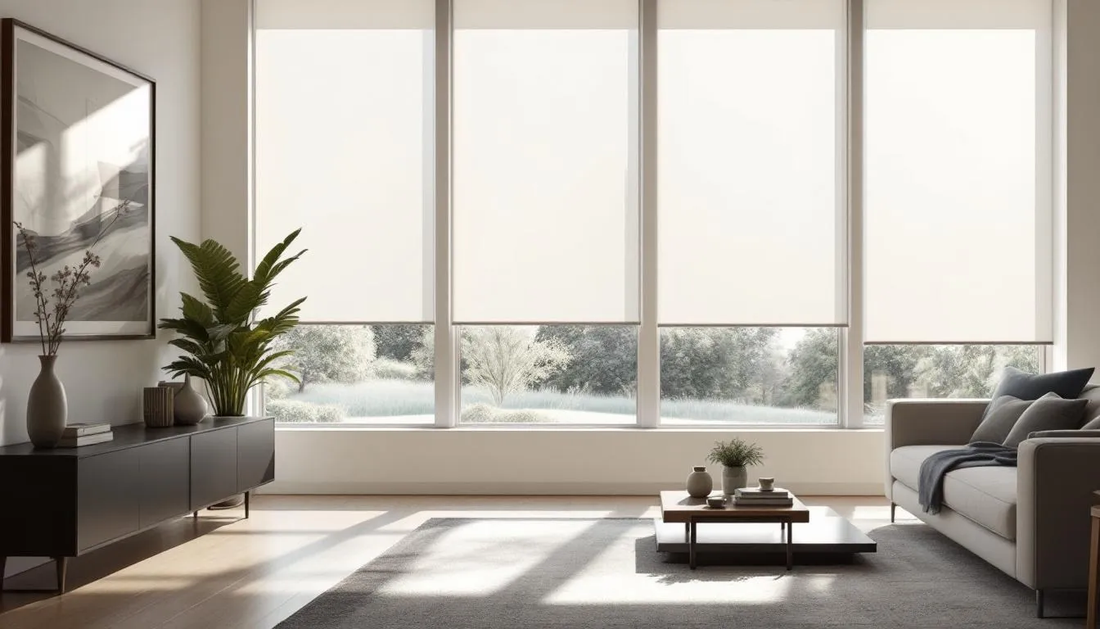
Smart Shades Alexa: Complete Guide to Voice-Controlled Window Treatments
Imagine transforming your daily routine with a simple voice command that opens your blinds to welcome the morning sun or closes your shades for an evening movie. Smart shades with Alexa integration represent one of the most practical advancements in home automation, combining motorized window treatments with the convenience of voice control to create a seamless smart home experience that can significantly improve your daily life and routines.
The integration of smart shades with Amazon’s Alexa ecosystem has revolutionized how we manage natural light, privacy, and energy efficiency in our homes. Unlike traditional window treatments that require manual operation, these intelligent systems respond to voice commands, smartphone apps, and automated schedules, making them essential smart home accessories for modern living.
This comprehensive guide will walk you through everything you need to know about smart shades Alexa integration, from understanding the technology and exploring top product options to setting up your system and maximizing its benefits within your broader smart home platform. In addition to Alexa, smart shades can also be integrated with apple home and other platforms, offering flexibility for users who want compatibility across different smart home ecosystems.
What Are Smart Shades with Alexa Integration?
Smart shades represent a significant evolution from traditional window coverings, incorporating motorized mechanisms and wireless connectivity to enable remote control through various smart home devices. When paired with Amazon Alexa, these motorized shades respond to voice commands, allowing users to adjust their window treatments without leaving their seat or reaching for a phone. During initial setup, you will need to pair your smart shades with your chosen platform to ensure proper integration and functionality.
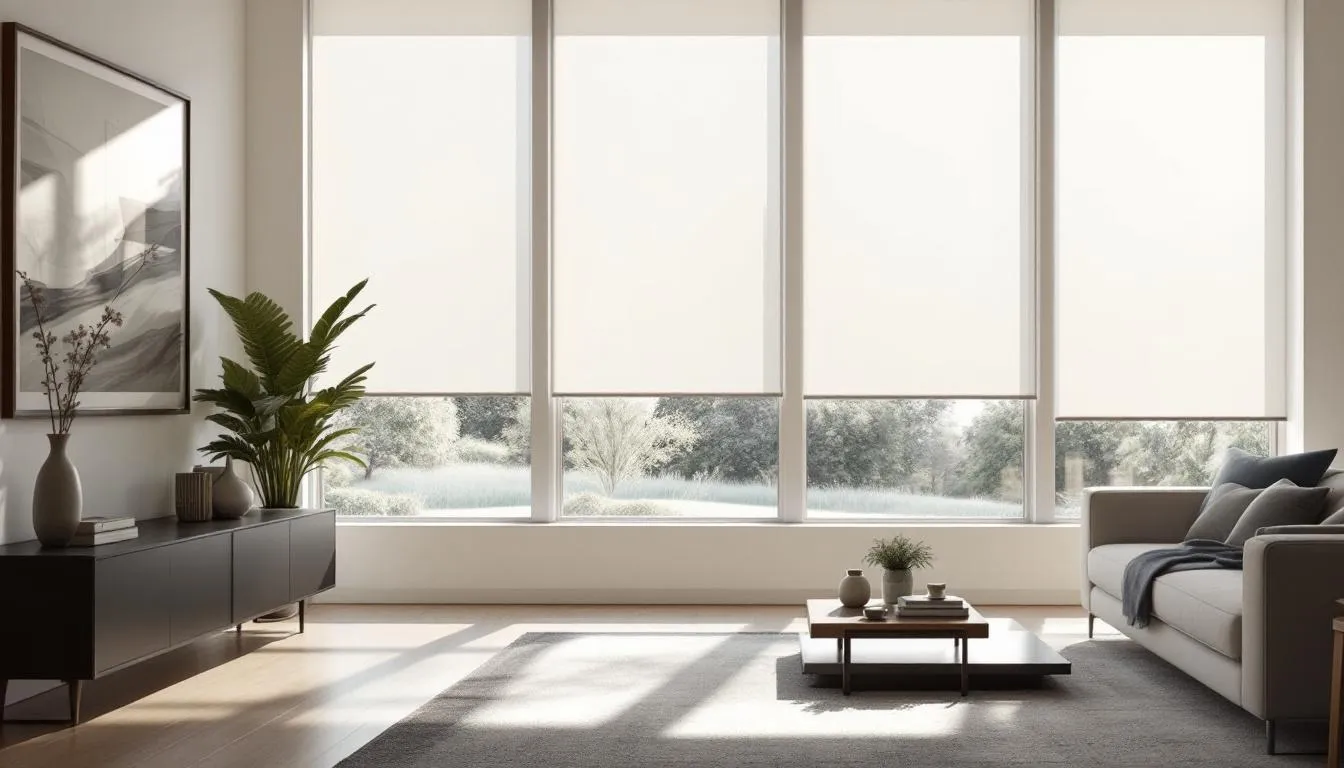
The core technology behind smart shades involves a motor system integrated with wireless communication modules that support wi fi, Zigbee, or Bluetooth connectivity. This allows the device to communicate with your home network and respond to commands from compatible smart devices like Echo Dot, Echo Show, Fire TV, HomePod mini, and other smart speakers. The integration creates a seamless experience where you can control lighting and privacy through simple voice commands such as “Alexa, open the bedroom blinds” or “Alexa, set the living room shades to 50 percent.”
Key features that define smart shades with Alexa compatibility include:
-
Motorized Operation: Quiet motors that can raise, lower, or tilt blinds with precision
-
App Control: Dedicated smartphone apps for manual control and scheduling
-
Voice Commands: Direct integration with Alexa for hands-free operation
-
Scheduling Capabilities: Automated opening and closing based on time, sunrise, or sunset
-
Scene Integration: Coordination with other smart home accessories, such as smart switches, for comprehensive automation
The compatibility extends beyond basic control to include integration with broader smart home ecosystems. Many smart shades work seamlessly with apple devices through Apple HomeKit, Google Home platforms, and other smart home hubs, creating a unified control experience. With Apple HomeKit, users can control their smart shades through the HomeKit app and set up HomeKit automation routines for customized scheduling and device interactions. This cross-platform compatibility ensures that your investment in smart shades enhances your entire smart home infrastructure rather than creating isolated functionality.
For users with existing smart home setups, smart shades can integrate with security systems, smart thermostats, appliances like air conditioners, and lighting controls to create sophisticated automation routines. You can also connect temperature sensors to automate shade adjustments for optimal comfort and energy efficiency. The ability to coordinate window treatments with other devices, including switches, through a single app or voice command represents a significant advancement in home automation convenience.
Top Smart Shades Compatible with Alexa in 2024
The market for Alexa-compatible smart shades has expanded significantly, offering options for every budget and installation preference. Here are the leading products that provide reliable Alexa integration and proven performance in real-world applications.
Lutron Serena Smart Shades
Lutron Serena represents the premium tier of smart shades, offering exceptional build quality and seamless Alexa integration. These motorized shades operate whisper-quietly and provide precise control through the Lutron app or direct voice commands. The system supports both battery-powered and hardwired installations, making it suitable for new construction and retrofit applications.
The Serena line integrates with Lutron’s broader smart home ecosystem, allowing coordination with smart lights and other devices through a single smart home hub. Price ranges typically start around $400 per window for standard sizes, positioning it as a premium option that justifies its cost through reliability and feature depth.
IKEA FYRTUR and KADRILJ Smart Blinds
IKEA’s entry into the smart shade market provides an accessible option for budget-conscious consumers without sacrificing Alexa compatibility. The FYRTUR blackout blinds and KADRILJ light filtering options offer essential smart functionality at prices starting under $150 per window.
These battery-powered blinds connect to IKEA’s TRÅDFRI smart home hub, which then integrates with Alexa through the IKEA Home smart app. While they lack some advanced features found in premium options, they provide reliable basic automation and voice control for users seeking an entry-level smart home upgrade.
Hunter Douglas PowerView Motorized Shades
Hunter Douglas PowerView systems combine the company’s reputation for quality window treatments with advanced smart home integration. The PowerView app provides comprehensive control, while the dedicated Alexa skill enables voice commands for individual shades or room-based groupings.
These shades excel in energy efficiency applications, with some models featuring insulating properties that contribute to climate control. The system supports both plug-in and battery power options, with solar charging available for select models. Pricing varies significantly based on window size and fabric selection, typically ranging from $300 to $800 per window. For assistance with custom window shades, contact World Wide Shades for expert guidance.
Soma Smart Shades 2
Soma offers a unique retrofit approach that transforms existing blinds into smart, Alexa-controlled systems. The Soma Smart Shades 2 attaches to existing beaded chain or cord loop blinds, making it an ideal solution for renters or homeowners who want to preserve their current window treatments.
Installation typically takes under 20 minutes per window, and the device features solar charging to minimize maintenance. The SOMA Connect Bridge enables Alexa integration, allowing voice control and scheduling through the same commands used with purpose-built smart shades. At around $180 per device, Soma provides excellent value for retrofit applications.
Yoolax Motorized Blinds
Yoolax offers direct Alexa compatibility without requiring additional hubs, simplifying installation and reducing system complexity. These motorized blinds connect directly to your wi fi network and appear as discoverable devices in the Alexa app.
The product line includes various styles from roller shades to cellular blinds, with prices starting around $200 per window. While lacking some premium features, Yoolax provides reliable basic functionality and straightforward setup that appeals to users seeking simple smart home integration.
Setting Up Smart Shades with Alexa
The setup process for smart shades varies depending on the specific product and your existing smart home infrastructure, but most systems follow a similar progression from physical installation to voice control activation. Each smart shade is treated as an accessory within the smart home ecosystem, and users may need to pair each accessory individually during setup.
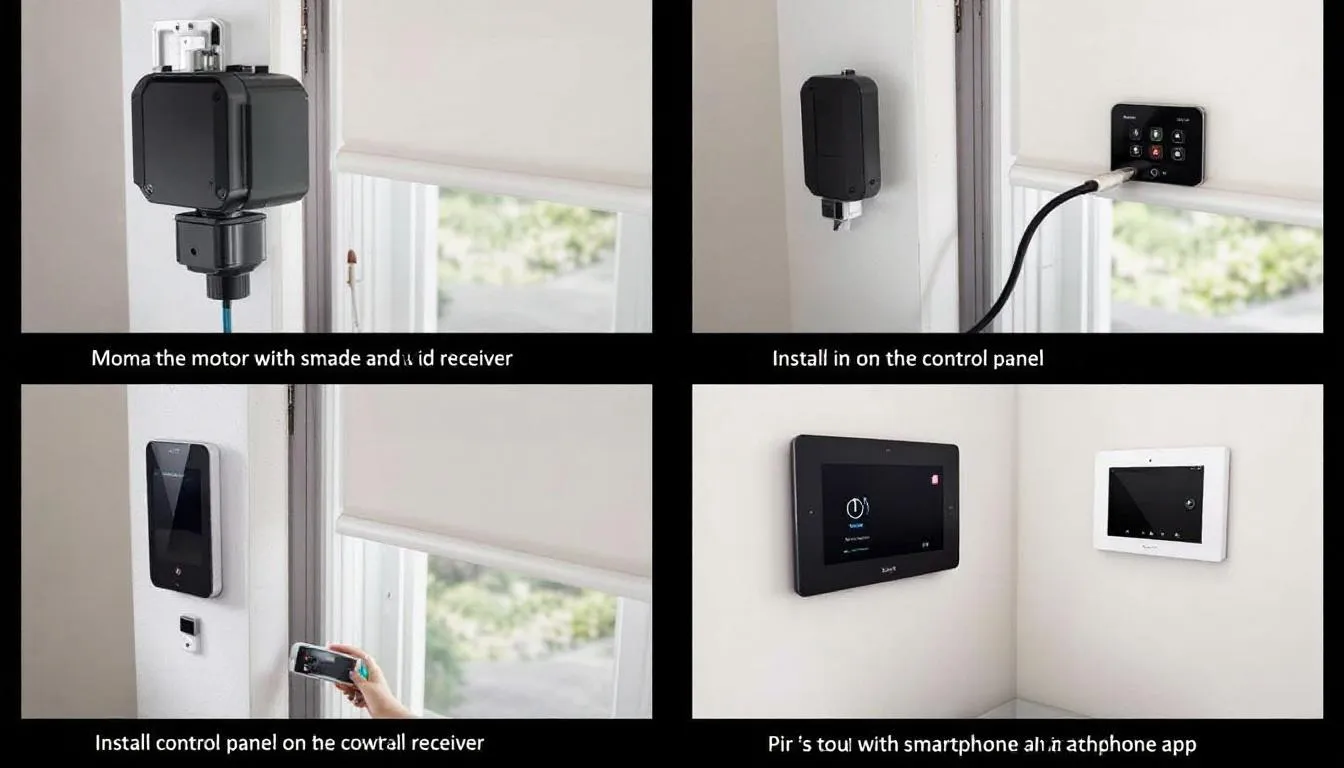
During device discovery or integration, users can also integrate other smart home devices such as garage doors, doors, and cameras for a more comprehensive smart home experience.
In the network setup, it is important to ensure a stable internet connection, as this is essential for remote control and automation of your smart shades and other devices.
For app setup, users of Apple HomeKit can use the homekit app for setup and management of their accessories.
Physical Installation Process
Begin by carefully measuring your windows and selecting the appropriate mounting option for your chosen smart shades. Most systems offer inside mount, outside mount, or ceiling mount configurations to accommodate different window types and architectural features.
For battery-powered systems, ensure the motor unit is properly charged before installation. Follow the manufacturer’s specific mounting instructions, paying particular attention to weight distribution and motor alignment. Many retrofit systems like Soma attach directly to existing blind mechanisms, while complete smart shade systems require removing old treatments and installing new mounting hardware.
Test the basic motor functions using the included remote or manual controls before proceeding to network setup. This ensures the mechanical components are working correctly and helps identify any installation issues early in the process.
Network Connection and App Setup
Download the manufacturer’s dedicated app and create an account if required. Most smart shades connect to your home wi fi network through the app, which typically involves putting the device in pairing mode to pair it with your network and app. Ensure you have a stable internet connection, as remote access and automation features depend on internet availability.
For systems requiring a smart home hub or bridge, connect the hub to your router via Ethernet cable and follow the app instructions to establish communication between the hub and your shades. This step is crucial for devices using Zigbee or other non-wifi communication protocols.
Apple users can use the HomeKit app for setup and device management, following prompts to add and configure the shades. Once connected to your network, test basic app functionality by opening and closing the shades through the smartphone interface. Configure any room assignments, shade names, or groupings that will make voice control more intuitive.
Alexa Integration and Device Discovery
Open the Alexa app and navigate to the “Devices” section to begin the discovery process. Most smart shades will appear automatically when you select “Discover Devices,” though some may require enabling a specific Alexa skill first.
For systems requiring dedicated skills, search for your manufacturer’s skill in the Alexa Skills store. Popular skills include “Lutron Caseta,” “Hunter Douglas PowerView,” and “IKEA Home Smart.” Enable the skill and link your manufacturer account to allow Alexa to access your device information.
After successful discovery, assign your shades to appropriate rooms within the Alexa app. This room-based organization enables commands like “Alexa, close all bedroom shades” and supports more sophisticated automation routines.
Alexa Skills and Voice Commands
The effectiveness of your smart shades depends largely on properly configured Alexa skills and understanding the available voice command options. Most manufacturers provide dedicated skills that unlock advanced functionality beyond basic open and close commands.
Essential voice commands include:
-
“Alexa, open [room name] blinds”
-
“Alexa, close living room shades”
-
“Alexa, set office blinds to 75 percent”
-
“Alexa, stop bedroom shades”
Advanced commands support partial positioning, allowing precise control over light levels and privacy. Practice with different percentage commands to find optimal positions for various lighting conditions and times of day.
Troubleshooting Common Issues
Connection problems typically stem from network issues or incorrect device naming. Ensure your wi fi signal is strong in the area where shades are installed, and consider using a mesh network system for large homes or areas with connectivity challenges.
If voice commands aren’t recognized, verify that device names in the Alexa app match what you’re saying. Avoid complex names or special characters that might confuse voice recognition. Simple, descriptive names like “living room blinds” work better than branded model names or technical designations.
For systems using smart home hubs, ensure the bridge device has power and network connectivity. Many connection issues resolve by restarting the hub and allowing devices to reconnect automatically.
Smart Shade Customization
One of the standout features of modern smart home devices is the ability to customize your environment to fit your lifestyle, and smart shade customization is no exception. With motorized shades that integrate seamlessly with compatible smart devices, homeowners can tailor their window treatments to suit their daily routines and preferences. Whether you’re using a smart home hub, smart plug, or a comprehensive smart home platform, the ability to control your shades alongside other smart home accessories brings a new level of convenience and efficiency.
Apple devices, such as iPhone and Apple TV, make it especially easy to manage your motorized shades. Through the Home app, you can group your shades with other home accessories—like lights, thermostats, and security systems—and control everything from a single app interface. This unified control center allows you to set up scenes, such as “Movie Night” or “Good Morning,” where your shades, lights, and even the temperature adjust automatically with one tap or voice command.
Scheduling is another powerful customization feature. You can program your smart shades to open at sunrise to gently wake you with natural light, or close in the afternoon to keep your home cool and protect your furniture from UV rays. This not only optimizes lighting and temperature but also helps manage energy use throughout the day. For those who value security, scheduling your shades to move at set times can give the appearance of an occupied home, even when you’re away.
With the flexibility to personalize settings, integrate with other smart devices, and control everything from your phone or TV, smart shade customization transforms your living space into a truly intelligent home environment.
Motion Sensor Technology in Smart Shades
Motion sensor technology is rapidly becoming a must-have feature in the world of smart home devices, and its integration into smart shades is changing the way we think about comfort and efficiency. By equipping motorized shades with motion sensors, your window treatments can automatically respond to movement, changes in lighting, and shifts in temperature—without you lifting a finger.
These sensors detect when someone enters or leaves a room, triggering the shades to open for natural light or close for privacy and energy savings. This hands-free control is especially useful in high-traffic areas or rooms where your hands are often full. When paired with other smart home accessories, such as lights and thermostats, motion sensor-equipped shades can help maintain the perfect ambiance and temperature throughout the day.
Security is another major benefit. Motion sensors can work in tandem with security cameras and smart locks, automatically closing shades when unexpected movement is detected or when the security system is armed. This adds an extra layer of privacy and protection, making your home feel safer and more secure.
The ability to automate your shades based on real-time activity not only enhances comfort but also contributes to energy efficiency by reducing unnecessary heating or cooling. With motion sensor technology, your smart shades become an integral part of a responsive, intuitive smart home system that adapts to your lifestyle.
Air Quality Considerations
Indoor air quality is a growing concern for many homeowners, and smart home devices are playing an increasingly important role in creating healthier living spaces. By integrating smart thermostats, air conditioners, and air quality sensors, you can monitor and improve the air you breathe—all from the convenience of your smart home platform.
Smart shades contribute to better air quality by automatically adjusting to block out pollutants, allergens, and harmful UV rays. For example, during high pollen days or periods of poor outdoor air quality, your shades can close automatically to help keep contaminants outside. When paired with smart thermostats and air conditioners, these adjustments can also help maintain optimal indoor temperature and humidity levels, further supporting a healthy environment.
Platforms like Apple HomeKit make it easy to bring all these devices together. With the Home app, you can view air quality data, control your shades, and adjust your climate settings from your iPhone or other Apple devices. This centralized control gives you the ability to respond quickly to changes in air quality, ensuring your home remains a comfortable and safe haven.
By leveraging the power of smart home devices and platforms, you can create a comprehensive system that not only enhances comfort and convenience but also prioritizes the health and well-being of everyone in your home.
Smart Home Integration and Automation
The true power of smart shades with Alexa emerges through integration with other smart home devices and automated routines that respond to environmental conditions, schedules, and user behavior patterns. Smart shades can be seamlessly integrated to control the entire house, including appliances, doors, and garage doors, providing comprehensive automation and enhanced convenience.
Creating Alexa Routines for Automated Control
Alexa routines transform smart shades from manually controlled devices into intelligent systems that anticipate and respond to your daily patterns. A well-designed morning routine might open shades gradually while turning on smart lights and adjusting your smart thermostat to create the perfect waking environment.
To create effective routines, consider your household’s daily schedule and seasonal variations. A “Good Morning” routine could open shades at sunrise during summer months but delay opening until later in winter when sunrise occurs earlier than your typical wake time. Evening routines can close shades while activating security systems and adjusting climate controls for optimal energy efficiency.
Routines also support conditional logic based on factors like weather conditions or occupancy sensors. Advanced setups can adjust shade positions based on outdoor temperature, closing them during hot afternoons to reduce cooling costs or opening them on mild days to take advantage of natural heating.
Integration with Lighting and Climate Systems
Smart shades work exceptionally well when coordinated with smart lights and smart thermostats to create comprehensive environmental control. During bright days, automated systems can close shades and dim artificial lighting to maintain consistent indoor conditions while reducing energy consumption.
The coordination becomes particularly valuable for climate control, as window treatments significantly impact heating and cooling efficiency. Smart shades can close automatically when air conditioners activate during peak temperature periods, reducing the load on cooling systems and lowering energy costs.
For homes with smart thermostats, integration allows temperature-based shade control that responds to both indoor and outdoor conditions. This creates a sophisticated system where window treatments actively contribute to maintaining comfortable temperatures while minimizing energy usage.
Security System Integration
Smart shades enhance home security through coordinated operation with security systems and cameras. Automated schedules can simulate occupancy by opening and closing shades at realistic times, even when you’re away from home for extended periods.
Integration with motion sensors enables responsive security features where shades close automatically when unauthorized movement is detected, providing additional privacy and potentially disrupting unwanted surveillance attempts. Some security systems can trigger shade closure during alarm conditions, adding another layer of protection.
Ring security systems and other compatible platforms can coordinate with smart shades to create comprehensive security routines that combine lighting, cameras, and window treatments for maximum effectiveness.
Cross-Platform Compatibility
Many smart shades support multiple platforms simultaneously, allowing integration with Google Home, Apple HomeKit, and other smart home ecosystems. This flexibility ensures that your investment remains valuable even if you switch between different voice assistants or smart home platforms.
Apple HomeKit integration enables control through the Home app on apple devices, while Google Home compatibility allows voice control through Google Assistant. Some advanced systems support all major platforms, giving users complete flexibility in how they interact with their smart home accessories.
The trend toward Matter compatibility promises even greater interoperability, with newer smart shade models supporting this universal standard that enables seamless operation across different platforms and manufacturers.
Benefits of Alexa-Controlled Smart Shades
The advantages of integrating smart shades with Alexa extend far beyond basic convenience, offering measurable improvements in energy efficiency, security, and accessibility that justify the investment for many homeowners.
Hands-Free Convenience and Accessibility
Voice control eliminates the need to manually operate window treatments, providing particular benefits for hard-to-reach windows, large installations, or users with mobility limitations. The ability to control multiple shades simultaneously through room-based commands creates convenience that traditional systems cannot match.
For elderly users or those with physical limitations, voice-controlled shades represent a significant accessibility improvement. Commands like “Alexa, open all shades” can instantly brighten a room without requiring physical movement or manual dexterity that traditional blinds demand.
The convenience extends to situations where hands are occupied, such as cooking or carrying items. Simple voice commands provide immediate control without interrupting other activities or requiring users to find and operate smartphone apps.
Energy Efficiency and Cost Savings
Automated shade control contributes to significant energy savings through intelligent responses to environmental conditions. Studies indicate that properly managed window treatments can reduce heating and cooling costs by 10-15% annually, with some high-performance installations achieving even greater savings.
The energy benefits come from strategic light management that reduces cooling loads during hot weather and maximizes natural heating during cooler periods. Smart shades can automatically adjust throughout the day to optimize solar gain while maintaining comfortable indoor temperatures.
Integration with smart thermostats amplifies these benefits by coordinating heating, cooling, and window treatments for maximum efficiency. The system learns optimal settings for different conditions and seasons, continuously improving performance over time.
Enhanced Security Features
Smart shades provide valuable security benefits through automated operation that simulates normal occupancy patterns even when residents are away. Scheduled opening and closing creates the appearance of normal activity, deterring potential intruders who monitor homes for signs of vacancy.
The integration with broader security systems enables responsive protection where shades automatically close during security events, providing additional privacy and potentially disrupting surveillance attempts. Some systems coordinate with security cameras to optimize viewing angles and lighting conditions for better monitoring.
Remote control capabilities allow homeowners to adjust shades from anywhere, enabling quick responses to changing weather conditions or security concerns even when away from home.
Improved Sleep and Wellness
Automated shade control supports better sleep patterns through gradual morning light exposure that helps regulate circadian rhythms. Blackout shades can close automatically at bedtime while slowly opening in the morning to provide natural wake-up lighting.
The system can adjust to seasonal changes in sunrise and sunset times, maintaining consistent sleep schedules throughout the year. This automatic adaptation eliminates the need for manual adjustments as daylight patterns change with the seasons.
Integration with smart lights enables sophisticated lighting scenes that coordinate natural and artificial light for optimal comfort and wellness throughout the day.
Installation and Maintenance Considerations
Successful smart shade implementation requires careful planning of installation requirements, power management, and ongoing maintenance needs that vary significantly between different product types and installation scenarios.
Professional vs. DIY Installation Options
The choice between professional and DIY installation depends on several factors including window type, electrical requirements, and the complexity of your chosen smart shade system. Retrofit solutions like Soma Smart Shades typically require only basic tools and can be completed in under 20 minutes per window, making them ideal for DIY installation.
Complete motorized shade systems often benefit from professional installation, particularly for large windows, custom sizes, or installations requiring electrical work. Professional installers ensure proper mounting, motor alignment, and integration with existing smart home infrastructure.
Consider professional installation for:
-
Multiple story installations or hard-to-reach windows
-
Custom-sized shades or complex window configurations
-
Hardwired systems requiring electrical connections
-
Integration with existing smart home hubs or complex automation systems
DIY installation works well for:
-
Standard-sized retrofit kits on accessible windows
-
Battery-powered systems with simple mounting requirements
-
Users comfortable with basic smart home device setup
-
Single-room installations or pilot projects
Power Management and Battery Considerations
Power requirements vary significantly between smart shade systems, with implications for installation complexity and ongoing maintenance. Battery-powered systems offer installation flexibility but require periodic charging or battery replacement, typically every 6-12 months depending on usage patterns.
Solar-powered options like those available from Soma and Hunter Douglas reduce maintenance requirements while providing sustainable operation. These systems work well for windows with adequate sunlight exposure but may require backup charging in areas with limited natural light.
Hardwired systems eliminate battery concerns but require professional electrical installation and limit future mobility. Consider hardwired options for permanent installations in new construction or major renovation projects.
Hybrid systems that support both battery and plug-in operation provide maximum flexibility, allowing battery operation during installation and testing followed by permanent power connections for long-term use.
Regular Maintenance Requirements
Smart shades require minimal regular maintenance, but consistent care ensures optimal performance and longevity. Basic maintenance includes periodic cleaning of shade materials according to manufacturer specifications and checking motor mounting for any loosening over time.
Battery-powered systems require monitoring charge levels through manufacturer apps, with most systems providing low-battery notifications well before power depletion. Establish a regular charging schedule based on usage patterns to avoid unexpected downtime.
Calibration adjustments may be necessary periodically, particularly for systems that rely on position sensors. Most smart shades include calibration routines in their apps that can be performed as needed to maintain accurate positioning.
Software updates are crucial for maintaining security and compatibility with evolving smart home platforms. Enable automatic updates where available, or check regularly for firmware updates through manufacturer apps.
Warranty and Support Considerations
Warranty coverage varies significantly between manufacturers and product lines, with premium brands typically offering longer warranty periods and more comprehensive coverage. Lutron and Hunter Douglas generally provide 2-5 year warranties, while budget options may offer 1-2 years of coverage.
Understand what warranty coverage includes, particularly for motorized components that experience the most wear over time. Some warranties cover only manufacturing defects while others include normal wear items like batteries and motor components.
Customer support quality becomes important for troubleshooting connectivity issues and coordinating warranty claims. Research manufacturer support reputation and available support channels before making purchasing decisions.
Consider purchasing from retailers that offer installation support and extended warranty options, particularly for complex installations or high-value systems where professional support justifies additional cost.
Cost Analysis and Budget Planning
Understanding the complete cost structure of smart shades implementation helps ensure realistic budget planning and optimal value from your investment in voice-controlled window treatments.
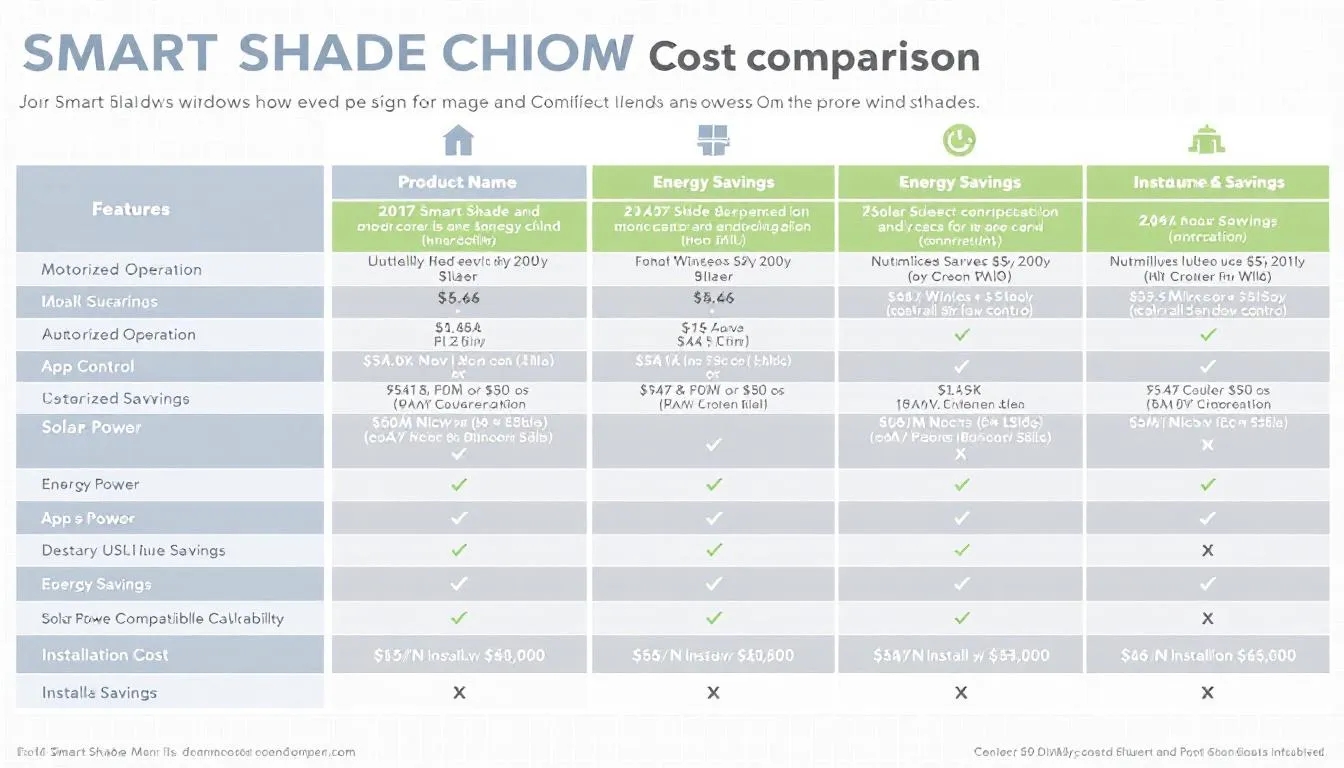
Price Ranges and Product Categories
Smart shade costs vary dramatically based on product type, window size, and feature complexity. Budget retrofit solutions start around $150-200 per window for basic models, while premium integrated systems can exceed $800 per window for large or custom installations.
Budget Category ($150-300 per window)
-
IKEA FYRTUR/KADRILJ smart blinds
-
Basic retrofit kits like entry-level Soma models
-
Simple motorized roller shades with basic Alexa compatibility
Mid-Range Category ($300-500 per window)
-
Hunter Douglas PowerView standard models
-
Yoolax motorized blinds with advanced features
-
Quality retrofit systems with solar charging and app control
Premium Category ($500+ per window)
-
Lutron Serena smart shades with full integration
-
Custom-sized Hunter Douglas PowerView installations
-
Professional installation with hardwired power systems
Retrofit vs. Complete System Cost Comparison
Retrofit solutions offer significant cost advantages for homeowners with existing window treatments in good condition. A complete retrofit installation might cost $200-300 per window compared to $400-800 for complete smart shade replacement.
However, complete systems often provide better aesthetics, quieter operation, and more precise control. The visual integration and professional appearance justify higher costs for prominent windows or comprehensive whole-home installations.
Consider retrofit solutions for:
-
Testing smart shade functionality before larger investments
-
Rental properties where permanent installation isn’t possible
-
Budget-conscious implementations in secondary rooms
-
Existing high-quality window treatments worth preserving
Choose complete systems for:
-
Primary living areas where aesthetics matter most
-
New construction or major renovation projects
-
Windows requiring professional installation anyway
-
Situations where maximum performance and reliability are priorities
Long-Term Value and Energy Savings
Energy efficiency benefits provide ongoing value that helps offset initial smart shade costs. Annual savings of 10-15% on heating and cooling costs can amount to $200-500 per year for typical homes, depending on climate and energy costs.
The payback period for energy savings alone typically ranges from 3-7 years, but additional benefits like convenience, security, and home value enhancement provide value that’s harder to quantify but equally important for many homeowners.
Smart shades can increase home value, particularly when integrated into comprehensive smart home systems that appeal to tech-savvy buyers. Real estate professionals often cite smart home features as differentiators in competitive markets.
Additional Cost Considerations
Factor in potential additional costs beyond the basic smart shade price:
-
Smart home hub requirements: $50-150 for systems requiring dedicated bridges
-
Professional installation: $100-300 per window for complex installations
-
Extended warranties: 10-20% of product cost for comprehensive coverage
-
Compatible smart devices: Cost of Alexa devices if not already owned
Setup and Integration Costs
-
Network infrastructure upgrades for reliable connectivity
-
Smart home platform subscriptions for advanced automation features
-
Professional consultation for complex multi-room installations
Budget for potential expansion costs if planning to start with a single room and expand later. Bulk installation often provides per-unit cost savings compared to piecemeal implementation.
Smart Shade Future Developments
The future of smart shades is bright, with new technologies poised to make these devices even more intelligent, efficient, and user-friendly. As the smart home market continues to evolve, we can expect to see smart shades that do more than just open and close—they’ll learn, adapt, and anticipate your needs.
Artificial intelligence (AI) and machine learning (ML) are set to revolutionize how smart shades operate. Imagine blinds that automatically adjust based on your daily habits, the weather forecast, or even the presence of people in the room. These features could include personalized lighting and temperature recommendations, ensuring your home is always comfortable and energy-efficient.
Innovations in materials and power sources are also on the horizon. Solar-powered shades and self-adjusting blinds will offer greater sustainability and lower maintenance, making them an attractive option for eco-conscious homeowners. As integration with other smart home devices deepens, expect to see even more seamless control over lighting, temperature, and security—whether you’re at home or away.
With these advancements, smart shades will become an even more essential part of the connected home, offering features and benefits that go far beyond traditional window treatments. The next generation of smart shades will not only enhance your comfort and convenience but also contribute to a smarter, greener, and more responsive living environment.
Conclusion
Smart shades with Alexa integration represent a compelling intersection of convenience, energy efficiency, and modern home automation that delivers measurable benefits for homeowners ready to embrace voice-controlled living. From budget-friendly retrofit solutions that transform existing blinds into smart home accessories to premium integrated systems that provide seamless operation and professional aesthetics, the market offers options for every budget and installation scenario.
The technology has matured to the point where compatibility concerns are minimal, setup processes are streamlined, and integration with broader smart home platforms creates genuinely useful automation capabilities. Whether you’re motivated by the hands-free convenience of voice commands, the energy savings potential of automated light management, or the security benefits of intelligent scheduling, smart shades deliver tangible value that justifies the investment.
Success with smart shades Alexa integration depends on careful product selection based on your specific needs, proper installation and setup, and thoughtful integration with your existing smart home ecosystem. Start by assessing your priorities—whether that’s budget, aesthetics, energy efficiency, or maximum automation capability—and choose products that align with those goals.
For homeowners ready to experience the convenience of voice-controlled window treatments, begin by evaluating your current windows and smart home setup to determine whether retrofit solutions or complete systems better suit your needs. With proper planning and realistic expectations, smart shades can transform your daily routine while contributing to a more efficient, secure, and comfortable home environment.

